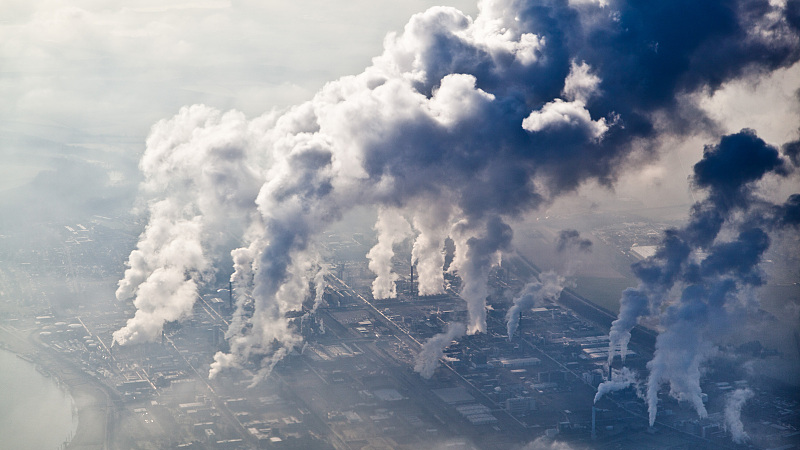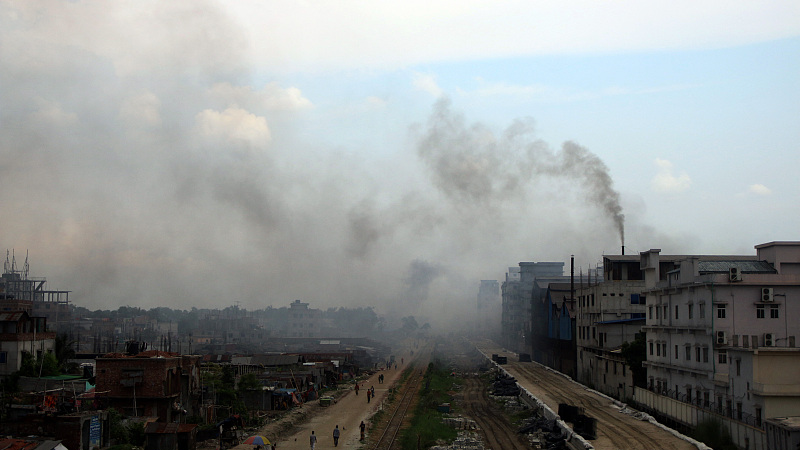
Editor's note: Alexander Ayertey Odonkor is an economic consultant, chartered financial analyst and chartered economist with an in-depth understanding of the economic landscape of countries in Asia and Africa. The article reflects the author's opinions and not necessarily the views of CGTN.
Air pollution is a major global challenge for our times, a blight standing as an existential threat to humanity, and according data from the World Health Organization (WHO) disclose that a whopping 99 percent of the world's entire population are exposed to air pollution levels that place them at an increased risk for several diseases including cancer, chronic obstructive pulmonary disease, heart disease, pneumonia and stroke.
An estimated 2.4 billion people are relying on high polluting fuels, such as charcoal, coal, animal dung, grass and wood for cooking, together with 91 percent of the world's total population are residing in places where air pollution levels exceed WHO guideline limits, a deplorable condition (ambient and household air pollution) that accounts for seven million premature deaths per year.
The appalling conditions could be exacerbated in the years ahead, coincided with burgeoning urbanization worldwide and a rising global population. So it's not rocket science to know that the worst is yet to come, particularly if present-day conditions do not improve considerably in the near future.
Air pollution, which is a pressing global challenge requiring all hands on deck to tackle, has not received much attention worldwide. For years, development funds earmarked projects designed to directly or indirectly address economic growth concerns. And not much has changed in recent years, as development financing designated to mitigate air pollution is far less important than funds apportioned to other development projects.
The State of Global Air Quality Funding 2021 revealed that between 2015 and 2020, only 0.7 percent of the total development finance reported by official development funds was spent on air pollution-related projects.
While this figure is extremely small, there is a bright side – total development funding for air quality from 2015-2020 have increased significantly, with a marked upturn in 2018-2020. Nevertheless, this growth is misleading, since progress is not evenly distributed worldwide – it is rather highly skewed, largely underpinned by new development funding for air quality-related projects in a few countries, spearheaded by China.
In Asia, which is the destination for more than 80 percent of the world's total development funding for air quality-related projects from 2015 to 2020, China accounts for the largest share of these funds in the region – a colossal green financing and investments for air quality that have yielded outstanding outcomes, a sharp contrast to other aid-recipient countries where the funding gap for air quality is widening and annual deaths attributed to air pollution is over four million, which accounts for 90 percent of all deaths attributable to outdoor air pollution – representing a 153 percent increase between 1990 and 2019.

Smoke rises from a re-rolling mill in Dhaka, Bangladesh, July 30, 2022. /CFP
Smoke rises from a re-rolling mill in Dhaka, Bangladesh, July 30, 2022. /CFP
Conversely, China's advocacy for green financing, scaling up innovative financing and investments for air quality-related projects have not only been successful in reducing air pollution but has also saved lives – between 2015 and 2020, the country recorded 8.6 percent decline in age-standardized deaths per 100,000 attributable to fine particulate matter (PM2.5) – a remarkable feat that could not have been realized, if China had failed to reduce air pollution drastically.
According to the University of Chicago's Energy Policy Institute, between 2013 and 2020 the quantity of fine particulate matter in the air in China dropped by 40 percent – a life-saving accomplishment that will add two years to average life expectancy if sustained. To put this into perspective, China's 40 percent drop in particulate matter within seven years is nearly equal to the 44 percent decline in air pollution in the United States, which was achieved over 30 years from 1970 after the Clean Air Act had become law.
China's enormous gains in the fight against air pollution have reduced global air pollution, but the hard truth is that this effort will not suffice and will take consistent innovative financing in all countries to address air pollution, particularly for countries in Africa and Latin America – two regions known to receive the least development funding for air quality, although air pollution is increasing rapidly there.
Admittedly, this task may be daunting but recent global trends have shown that, it is possible to turn things around within a short duration. While China has demonstrated how strengthening innovative financing can offer new solutions to curb air pollution, lock downs enforced in most countries worldwide to control the spread of the COVID-19 pandemic also provide vital lessons as they reduced global air pollution significantly within a few months. According to a report (2021) from the United Nations, fossil-fuel emissions, which accounted for 85 percent of all carbon dioxide emissions between 2010 and 2019, declined by 5.6 percent in 2020, the largest annual decline ever recorded in absolute values – the transport sector, mainly the road transport contributed the largest to the drop.
Recent data show that while the transport sector accounts for one-fifth of global carbon dioxide emissions, road travel alone contributes three-quarters of the total – the largest share representing 45 percent comes from passenger vehicles. Suggesting that decarbonizing the transport sector, especially the road transport is key to mitigating global air pollution.
Nonetheless, this onerous task will require massive funding to undertake effective electric mobility transition, renewable energy research and development and to bring on board innovative small and medium-sized enterprises to strengthen clean energy transition, a demand the traditional financing especially those in Low Income Countries are grappling to meet.
This revelation should serve as a wake up call to development funds and relevant stakeholders – global air pollution could be reduced considerably and effectively if innovative financing for air quality-related projects is prioritized across the globe.
(If you want to contribute and have specific expertise, please contact us at opinions@cgtn.com. Follow @thouse_opinions on Twitter to discover the latest commentaries in the CGTN Opinion Section.)

